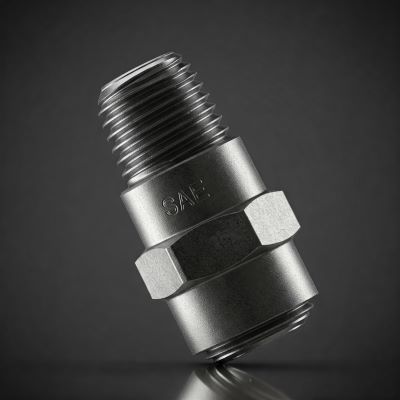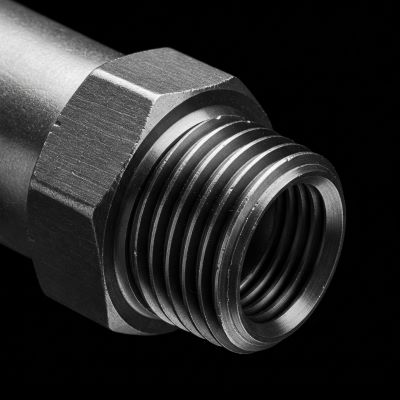Thread types play a crucial role in various industries, including mechanical, plumbing, and automotive. They ensure secure connections, prevent leaks, and enable proper functioning of components. While numerous thread standards exist, two of the most common are SAE and NPT. Although both are widely used, they serve distinct purposes and exhibit significant differences in their design and application.
This blog post will delve into a detailed comparison of SAE and NPT threads, covering their geometry, applications, and performance characteristics.
What are SAE and NPT Threads?
SAE Threads
SAE (Society of Automotive Engineers) threads are a family of thread standards developed by the Society of Automotive Engineers. They are extensively used in automotive and industrial applications where strength and durability are paramount.
The SAE encompasses a wide range of thread standards, including:
➡ Unified Thread Standard (UTS): A comprehensive system covering various thread profiles, including coarse, fine, and extra-fine pitches.
➡ SAE J476: Specifies thread dimensions for bolts, screws, and nuts used in automotive applications.
NPT Threads
NPT (National Pipe Thread) is a standard for tapered pipe threads primarily used in plumbing and pipe fitting applications.
They are primarily used for connecting pipes and fittings in fluid and gas transportation systems, particularly in the oil and gas industry.
The NPT standard includes:
➡ NPTF (National Pipe Taper Fuel): Designed for fuel systems and less critical applications.
➡ NPTT (National Pipe Taper Tapered): Offers a tighter seal than NPTF and is suitable for high-pressure applications.
Thread Geometry: SAE vs. NPT
SAE Thread Geometry
➡️ Straight: SAE threads are straight, meaning they have a constant diameter along their length.
➡️ Pitch, Depth: The pitch (distance between threads) and thread depth are designed to provide a secure mechanical connection.
➡️ Fit: SAE threads can be external (male) or internal (female) and are typically designed for a specific fit, such as a loose fit or a close fit.
NPT Thread Geometry
➡️ Tapered: NPT threads are tapered, meaning they gradually decrease in diameter from the root to the crest. This taper is crucial for achieving a tight seal.
➡️ Pitch, Angle, Depth: NPT threads have a 60-degree thread angle and a specific taper rate. The pitch and depth are designed to work in conjunction with the taper to create a seal.
➡️ Sealing: The tapered design of NPT threads allows them to form a tight seal when mated. As the threads are screwed together, the taper creates a compression fit, effectively sealing the joint.
Applications of SAE and NPT Threads
SAE Applications
➡️ Automotive: Widely used in various automotive components, including:
➡ Engine components (bolts, nuts, studs)
➡ Brake lines
➡ Fuel systems
➡ Steering systems
➡ Suspension components
➡️ Industrial Machinery: Used in various industrial machinery and equipment, such as:
➡ Construction equipment
➡ Agricultural machinery
➡ Manufacturing equipment
NPT Applications
➡️ Plumbing: The most common application for NPT threads is in plumbing systems, including:
➡ Water pipes
➡ Gas lines
➡ Drainage systems
➡️ Oil and Gas: Extensively used in the oil and gas industry for:
➡ Connecting pipelines
➡ Oil and gas wellhead equipment
➡ Refinery equipment
➡️ Other Applications:
➡ Compressed gas systems
➡ Chemical processing equipment
Performance: How SAE and NPT Compare
Sealing Capabilities:
➡️ SAE: SAE threads typically require the use of sealants (e.g., Teflon tape, thread lock) to ensure a leak-proof seal.
➡️ NPT: The tapered design of NPT threads inherently provides a tight seal, often eliminating the need for additional sealants.
Strength and Durability:
➡️ SAE: SAE threads are designed for high strength and durability, making them suitable for high-pressure and high-stress applications.
➡️ NPT: NPT threads also exhibit good strength and durability, particularly in pipe fitting applications.
Ease of Use and Assembly:
➡️ SAE: SAE threads are generally easier to assemble due to their straight design.
➡️ NPT: NPT threads can be more challenging to assemble due to the tapered design, which requires careful alignment and tightening to avoid cross-threading.
Choosing Between SAE and NPT
The choice between SAE and NPT threads depends on several factors:
➡️ Application:
➡ For automotive and most industrial applications, SAE threads are generally preferred.
➡ For plumbing, gas lines, and oil and gas applications, NPT threads are the standard.
➡️ Compatibility: Ensure compatibility with existing systems and components.
➡️ Sealing Requirements: If a tight seal is critical, NPT threads are often the better choice.
➡️ Working Conditions: Consider the operating conditions, including pressure, temperature, and exposure to chemicals.
Key Differences at a Glance
Here are the key differences of SAE and NPT explained in a table:
|
Feature |
SAE Thread |
NPT Thread |
|
Thread Type |
Straight |
Tapered |
|
Common Applications |
Automotive, hydraulic systems |
Plumbing, gas, oil pipelines |
|
Sealing Method |
Requires additional sealants |
Self-sealing (due to taper) |
|
Thread Strength |
High for industrial use |
Strong in pipe fitting systems |
|
Ease of Installation |
Easier to assemble |
More complex due to tapering |
Conclusion
This blog post has provided a comprehensive comparison of SAE and NPT threads, highlighting their key differences in geometry, applications, and performance. By understanding the unique characteristics of each thread type, engineers and technicians can make informed decisions when selecting the most appropriate thread for their specific project requirements.
Remember that proper thread selection is crucial for ensuring the safety, reliability, and longevity of any mechanical or plumbing system.
Post time: Jan-28-2025



